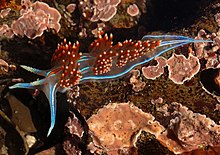
Nudibranchs are a group of soft-bodied marine gastropod molluscs that shed their shells after their larval stage. They are noted for their often extraordinary colours and striking forms, and they have been given colourful nicknames to match, such as "clown", "marigold", "splendid", "dancer", "dragon", and "sea rabbit". Currently, about 3,000 valid species of nudibranchs are known.

Velella is a monospecific genus of hydrozoa in the Porpitidae family. Its only known species is Velella velella, a cosmopolitan free-floating hydrozoan that lives on the surface of the open ocean. It is commonly known by the names sea raft, by-the-wind sailor, purple sail, little sail, or simply Velella.
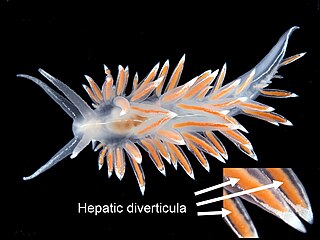
As applied to mollusks, the Neo-Latin term diverticulum is an anatomical feature. The term is most often encountered in the plural form as "diverticula", "hepatic diverticula", or "digestive diverticula", which are anatomical terms for organs which are visible from the outside of the body in a clade of sea slugs known as aeolid nudibranchs, marine opisthobranch gastropod molluscs.

Aeolidia papillosa, known as the common grey sea slug, is a species of nudibranch in the family Aeolidiidae.

Phidiana hiltoni is a species of sea slug, an aeolid nudibranch, a shell-less marine gastropod mollusc in the family Facelinidae.

Doto amyra, or the hammerhead doto, is a species of very small or minute sea slug, a nudibranch, a shell-less marine gastropod mollusk in the family Dotidae.

Nembrotha lineolata is a species of nudibranch, a sea slug, a marine gastropod mollusk in the family Polyceridae. It is found in shallow water in the Indo-Pacific. It was first described in 1905 by the Danish malacologist Rudolph Bergh. The type locality is Selayar Island, Indonesia.

Dendronotus albus is a species of sea slug, a dendronotid nudibranch, a shell-less marine gastropod mollusc in the family Dendronotidae.

Hermissenda is a genus of sea slugs, aeolid nudibranchs, marine gastropod molluscs in the family Facelinidae.
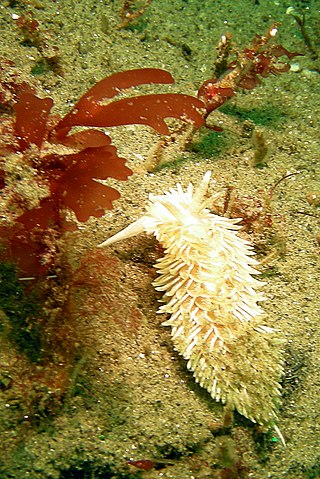
Ziminella salmonacea, common name the salmon aeolis, is a species of sea slug, an aeolid nudibranch, a marine gastropod mollusc in the family Paracoryphellidae.
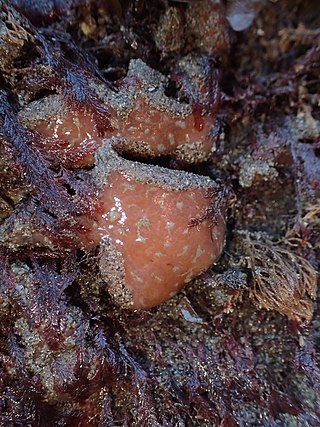
Aplidium solidum is a species of colonial sea squirts, a tunicate in the family Polyclinidae. It is commonly known as the red ascidian or sea pork.

Polycarpa aurata, also known as the ox heart ascidian, the gold-mouth sea squirt or the ink-spot sea squirt, is a species of tunicate in the family Styelidae.
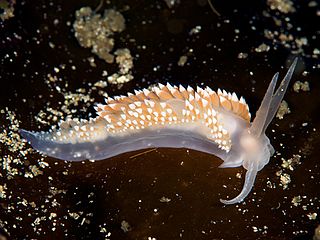
Coryphella verrucosa, is a species of sea slug, an aeolid nudibranch, a marine gastropod mollusc in the family Coryphellidae.

The predaceous aeolis is a species of sea slug, an aeolid nudibranch, a marine heterobranch mollusc in the family Flabellinidae. This species was commonly known as Flabellina fusca, a junior synonym.
Doto acuta is a species of sea slug, a nudibranch, a marine gastropod mollusc in the family Dotidae.
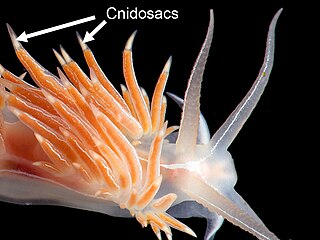
A cnidosac is an anatomical feature that is found in the group of sea slugs known as aeolid nudibranchs, a clade of marine opisthobranch gastropod molluscs. A cnidosac contains cnidocytes, stinging cells that are also known as cnidoblasts or nematocysts. These stinging cells are not made by the nudibranch, but by the species that it feeds upon. However, once the nudibranch is armed with these stinging cells, they are used in its own defense.

Ancula lentiginosa is a species of sea slug, a dorid nudibranch, a marine gastropod mollusc in the family Goniodorididae.
Tenellia punicea is a species of sea slug, an aeolid nudibranch, a marine gastropod mollusc in the family Fionidae.

Hermissenda opalescens is a species of brightly coloured sea slug or nudibranch, a marine gastropod mollusc in the family Facelinidae.
Tritoniella is a genus of sea slugs, specifically dendronotid nudibranchs. It is a marine gastropod mollusc in the family Tritoniidae.The genus was described in 1907 by the British diplomat and malacologist Charles Eliot.
